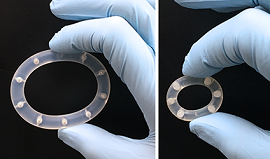Though antiretroviral drugs to combat HIV infection are already available, researchers are constantly looking for the right combination and delivery mechanism that would allow complete protection against the virus. A team in California may have come across the answer.

Scientists at the Oak Crest Institute of Science have shown in a first-of-its-kind result that an FDA-approved combination of the antiretroviral tenofovir disoproxil fumarate (TDF) and emtricitabine (FTC) packed into an intravaginal ring could protect against HIV completely when delivered topically in animal tests.
What’s more, the ring can remain protective for over four and a half months, according to the institute. In the past, the success of antiretrovirals has been hampered by low adherence rates when it comes to oral administration or other topical methods. Because the ring can stay in place for so long, releasing the drugs steadily throughout several menstrual cycles, adherence rates would no longer be an issue.
And for the developing world, where HIV protection is especially crucial, long-lasting rings are less expensive per patient and require less infrastructure to provide to communities than daily therapies.
“We are extremely pleased with the results of this study,” Marc Baum, president at Oak Crest, said in a news release. “The observed protection in macaques indicates the significant potential for the TDF-FTC drug combination delivered via the pod-IVR to successfully prevent sexual HIV infections in humans.”
Currently, TDF and FTC are only approved by the FDA as an oral combination.
“The novel and versatile drug delivery system that our team is developing has proven that it has the capacity to deliver and maintain protective levels of multiple drugs,” Baum said in the release. “Protection against (S)HIV virus that was observed in this study warrants clinical evaluation of the pod-IVR design and the sustained delivery of a variety of AVRs to find the best combination possible.”
- here's the Oak Crest release
Related Articles:
Vaginal ring shields some women from HIV in NIH-backed study
Silicone vaginal ring could deliver HIV, herpes drugs at low cost
Columbia Labs picks up multidrug intravaginal ring created at MIT and MGH
HIV-fighting intravaginal ring research nets $20M from NIH